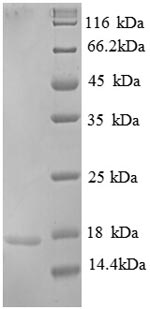The production of the recombinant Human RPA3 protein begins with the creation of the recombinant plasmid, which is synthesized by inserting the gene encoding the Human RPA3 protein (1-119aa) into a plasmid vector. The recombinant plasmid is introduced into e.coli cells. e.coli cells that can survive in the presence of a specific antibiotic are selected and then cultured under conditions conducive to the expression of the gene of interest. The protein is equipped with a N-terminal 6xHis tag. Following expression, the recombinant RPA3 protein is isolated and purified from the cell lysate using affinity purification. Denaturing SDS-PAGE is then employed to resolve the resulting recombinant Human RPA3 protein, demonstrating a purity exceeding 90%.






